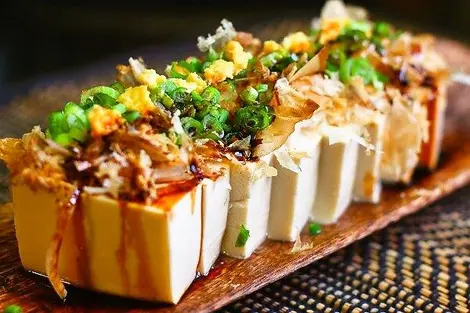Tofu in Japanese cuisine
- Published on : 30/09/2018
- by : F.F.Y.
- Youtube
Cheap, versatile, delicious!
Tofu is an extremely versatile ingredient, much appreciated by the Japanese and often used in their culinary specialties. Not only does it come in many different forms, but it also lends itself well to all sorts of flavors. It is, of course, also a common substitute for meat. During a visit to Japan it's likely that you'll see tofu served in a variety of ways.
Tofu in everyday dishes
Tofu is a staple of the Japanese diet. It's a common ingredient in miso soup, where it's found in small cubes, and is consumed almost every day this way. And then there's nabe or "hotpot", a common winter dish in which tofu is either substituted for meat, or eaten in addition to meat and vegetables.
See : Nabe, Japanese hotpot
More unusual for Western palates, there is yudofu, a very simple dish where a cube of tofu is simply served hot, with dashi broth as the only seasoning. Variations of this dish exist using different sauces, but most stick to the most basic preparation that allows diners to fully appreciate both the taste and texture of the tofu.
Tofu can also be found in basic sauce dishes, such as mabodofu (originally from China) where diced tofu is simmered in a spicy sauce with beef or pork. This dish is usually served hot, along with white rice.
Another relatively simple Japanese dish involving an unusual form of tofu is unohana. This dish consists of a mixture of sautéed vegetables crowned with okara, soya pulp. Okara is made from insoluble residues from the making of tofu. In this sense, it's a kind of tofu dish!
Cold tofu, fried tofu
Tofu-based specialties can come in surprising forms for those new to Japanese cuisine: it's often served cold, for example, as in hiyayakko, a dish where silken tofu is enjoyed in its simplest form, a cube seasoned only with a little soy sauce, wasabi or green onion.
Related : Wasabi
For another type of tofu, try iburidofu, a tofu that tastes a bit like cheese! It's a firmer tofu, with a stronger taste since it is pressed and more importantly, smoked.
It's this type of tofu that is found seasoned with various flavors in some food stores in the West. The Japanese eat it alone, as if it were meat or cheese.
Another popular way of eating tofu is to serve it fried. Similar to iburidofu, it's called atsuage, but unlike the smoked version, it is simply fried.
Among the uses of fried tofu, there is aburaage, made by cutting very thin slices of tofu and frying them. These sheets of tofu are used in inari-zushi or the famous kitsune udon.
Related: Udon
A last example of fried tofu is agedashidofu. This dish is very popular in izakaya in Japan, or served as a snack or starter in restaurants: it's crispy fried tofu cubes, served in a tsuyu (dashi and soy-based) sauce and topped with grated radish, green onions and dried bonito flakes. Sort of like a hot, deep fried version of hiyayakko.
Going vegetarian: with tofu, it's easy!
Tofu appears regularly at the table of Buddhist monks, who follow a strictly vegetarian diet and as a result have developed their own cuisine called shojin ryori. Tofu provides protein and energy that would have otherwise come from meat. The monks of Mount Koya developed their own tofu recipe, koyadofu, which consists of frozen fried tofu, then thawed, which gives it an absorbent spongy texture. It can then be used as desired in broths, or in sauce with vegetables. This is a good example of tofu used as a meat substitute.
Another traditional vegetarian recipe is yuba or "tofu skin". This is the skin that forms after boiling soy milk, which is then dried. Even if yuba isn't actually tofu (it doesn't use the same manufacturing process), it's often called tofu because it can have similar texture and taste characteristics. Yuba is popular in the Nikko region and found in all kinds of sauces.
To read : Being vegetarian in Japan
There's only one way to eat a complete meal of tofu: tofu kaiseki. This is a version of the famous Japanese gourmet meal kaiseki ryori, entirely made from soy products. Kaiseki tofu dishes are refined and well-studied, and in fact, the tofu forms encountered are incredibly varied: cold, hot, silky or firm, fried or thawed, broth, even dessert... it's the ultimate tofu experience. This meal, served mainly in Kyoto, honors all the variations of this magic ingredient.

























